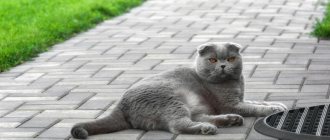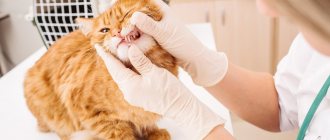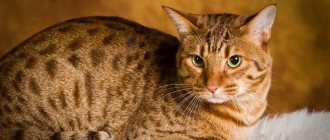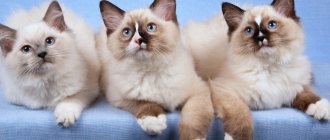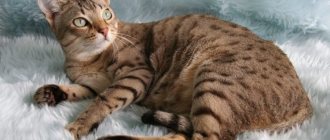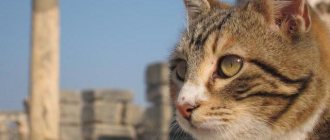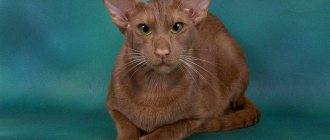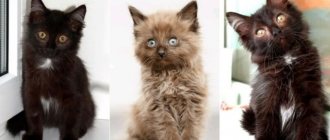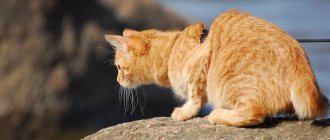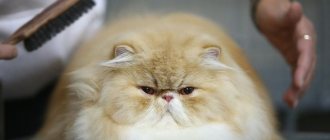History of the Ukrainian Levkoy breed
The first representative of the Ukrainian Levkoy breed was released in January 2004 in Kyiv. Its appearance was the result of an experiment by the famous felinologist Elena Biryukova. The kitten's parents were a Don Sphynx and a Scottish fold cat. The baby was born with velor fur, his eyes were almond-shaped, and his ears were bent forward. Already in 2006, the offspring of the first representative of the hairless fold-eared breed numbered 40 individuals.
The first Russian nursery for breeding fold-eared hairless cats appeared in 2007 in St. Petersburg. Currently, the breed is not recognized by all international organizations. The WCA (World Cat Association) recognized the right of Ukrainian Levkoys to participate in exhibitions and gave them the opportunity to receive the title of champions. Hairless Folds are not yet recognized by the WCF (World Cat Federation), but in 2012, after their official introduction, a preliminary breed standard was adopted.
The petals of the gillyflower are neatly folded, just like the ears of bred cats.
The name of the new breed was not immediately thought up. At some point, the similarity of the ears of an unusual hairless kitten with the petals of a beautiful Levkoy plant was noticed, and since the baby was born in Kyiv, the name appeared - Ukrainian Levkoy.
Wool
According to breed standards, kittens can be born with different hair parameters; several characteristics are distinguished:
- complete absence of hair on the entire body;
- partial remains of fur on the points;
- velor fur covering the body.
The beautiful velor Ukrainian Levka is distinguished by the presence of fur from 1 to 3 mm long, evenly covering the entire body of the animal.
Breed Features
The Ukrainian Levkoy, according to the WCF provisional standard, is a hairless cat whose unusual feature is lop ears. The body of the individual is medium in size, elongated, with good muscles. The animal is soft and hot to the touch.
Appearance
A detailed description of the Ukrainian Levkoy includes the following criteria:
- Head. It has the shape of an elongated wedge. The size is average. If you look from above, it will look like a pentagon with rounded outlines, longer than wide. The cranial area is impressive, the forehead is almost flat. The cheekbones are strongly pronounced and located high.
- Nose. Not long and not short, not wide. It features a smooth transition to the forehead and has a small step at eye level.
- Muzzle. Without sharp corners, rounded. The mustache may be absent, stiff or crimped.
- Eyes. They have an almond shape. Not completely open, slightly slanted. Can be of any shade.
- Ears. Widely located. In the middle part they have a forward bend. They can be almost pressed to the head or slightly raised.
- Torso. Medium size, strong, but not massive. Males are usually larger than females. The chest is oval-shaped, not wide, the back is slightly arched.
- Tail. Short and flexible.
- Limbs. Elongated and powerful. Paws are oval-shaped with long toes and webbed feet.
- Skin covering. There must be folds on it: between the ears, on the neck, in the groin area and under the armpits. Can be completely hairless or covered with fur up to 2 mm (flock type). Partial presence of vegetation on points (brush point type) is also allowed. Straight-haired and brush-coated dogs participate in breeding, but are not allowed for exhibitions. The color can be any.
The Ukrainian Levkoy has amazingly beautiful almond-shaped eyes and unusual forward-curved ears.
Character and behavior
Activity, devotion to people and sociability can be called the main character traits of Ukrainian Levkoys. In addition, these animals are extremely intelligent and easy to train. Thanks to these qualities, Ukrainian Levkoys can be called absolutely problem-free pets and ideal companions.
They easily get along with all household members and other pets. They are very attached to a person, constantly need his presence and communication - they can sit next to him or lie on his lap for hours. Levkoys are sensitive to changes in the mood and well-being of the owner. If the owner is preoccupied with something or feels unwell, the pet will not leave him a single step, will caress and purr until he considers that he has managed to correct the situation.
Ukrainian Levkoys get along well with other pets
Ukrainian Levkoys are unusually playful - they enjoy playing with various kinds of toys or actively spending time with children. They are not vindictive, not aggressive and rarely enter into conflicts.
Little lefties quickly get used to the tray. When visiting it, they behave very carefully - the owner will never see the filler scattered around. Pets are easy to train; if desired, they can be taught simple commands and tricks. It’s not for nothing that many compare their character and behavior to that of a dog.
Levkoys need to know that they are needed, the most important thing for them is the affection and attention of the owner. Loud, sharp sounds and violence are unacceptable for them, but the pets will enjoy the gentle praise of the owner or calm, soothing music. If a person treats the left-handed dog with attention and love, the animal will definitely respond in kind and will not create any problems.
One wise man said something like this: “It only takes a moment to be surprised, but it takes years to create something that can surprise.” It took a lot of time to create a cat with amazing appearance, friendliness and high intelligence. Before starting breeding, Elena Biryukova drew images of future cats on paper.
Video: Ukrainian Levkoy - all about the breed
Character
The Ukrainian Levkoy is an intelligent and loyal animal. In addition to their calm nature, Ukrainian animals, like all hairless cats, have a good disposition and experience boundless love for their owner.
The high intelligence of a pet is another important feature. It will not be difficult for Levkoys to remember all the commands: where the toilet is, where they are allowed to sleep, and others.
They can actively help the owner in household chores. They are very smart, so they will get out of any difficult situation and will not enter into conflict just like that. They will be loyal to their master. Such cats require attention, so do not forget to devote time to your pet.
Purchasing a kitten
To protect yourself from unpleasant surprises, it is best to purchase a Ukrainian Levkoy kitten from nurseries with a positive reputation. Before you take a responsible step, you should study the breed standards. If a pet is purchased simply for the soul, then when choosing, you can rely on intuition and personal sympathies.
The kitten must be healthy, friendly and active. A visual examination will help to assess his physical condition - a healthy baby should not cough or sneeze or itch. His eyes and ears should be clean, his gums should be healthy, his skin should be smooth and soft, without dry areas or redness. The tummy should be round, but not bloated.
If it is assumed that the animal will participate in exhibitions, then it is necessary to assess whether its appearance meets the standards. The structural features of the head are among the main breed characteristics. Its shape should be wedge-shaped, the cheekbones and brow ridges are clearly defined. The muzzle is not too elongated in length, the chin and jaw should be well developed. A prerequisite is the presence of folds on the head, neck, armpits and groin.
There must be folds on the skin of a Ukrainian Levkoy kitten - on the neck, head, armpits and groin.
At what age is it better to buy
Not a single truly competent and loving breeder will give away a cub before it turns 3 months old. It is by this time that the animal is ready for independent life; it has received all the necessary vaccinations.
Drawing up a purchase and sale agreement is a prerequisite for purchasing a purebred kitten. The breeder must also provide the owner with a birth certificate, pedigree and veterinary passport.
Completely hairless kittens are much more expensive than those covered with light fluff. But those with a brush type of coat at birth are likely to “undress” with age.
Contents of Ukrainian Levkoy
The responsibilities of the owner of a cat of any breed include competent and regular care. The maintenance and hygiene of Ukrainian Levkoy have some nuances.
Pet care
Particular attention should be paid to caring for the animal’s unusual skin. A special secret produced by the cat's sebaceous glands tends to accumulate on the surface of the skin. It causes discomfort when touched and does not smell very good. Wiping with special wet wipes will help solve the problem.
The delicate skin of Ukrainian Levkoys requires special care.
Bathing the animal using special shampoos or tar soap should be done no more than 2 times a month. Too frequent water procedures remove protective lubricant, making the skin dry and more susceptible to various types of rashes. The Ukrainian Levkoy is not too keen on taking a bath, but by teaching him to do so from a very young age, you can overcome his fear of water.
Your pet's ears should be examined every two weeks. They should be cleaned using wet wipes or cotton swabs soaked in warm water. During the procedure, you should not penetrate deep into the ear canal to avoid injury. If during inspection the owner finds something suspicious, he should immediately contact a specialist.
The animal's eyes also need regular care. Transparent and moderate discharge is normal. Wiping with a napkin or sponge, which can be soaked in weak tea leaves, will help get rid of it. If there is excessive drainage from the eyes, you should contact your veterinarian.
Caring for a left-handed dog also includes mandatory nail trimming approximately once a month. A special nail clipper is used for this purpose. It is necessary to trim the light, translucent part of the claw, because the pink part contains blood vessels.
It is necessary to accustom your dog to brushing its teeth from an early age. For this purpose, you can use a special paste and brush or a special treat. To prevent the formation of tartar, you should regularly show your pet to a specialist.
Tray training
Ukrainian Levkoys are distinguished by their neatness and cleanliness. They are usually litter box trained from a very early age by their mother cat. Upon arrival at a new place of residence, it is worth showing them once where the toilet is, and you can be sure that the pet will not relieve itself somewhere else. While the kitten is getting used to the new environment, it is better to use the same litter for the tray that was used in the nursery. In the future, owners can choose it as they wish.
Nutrition
Due to their fast metabolism, Ukrainian Levkoys have an excellent appetite. They are not very picky and enjoy eating even plant foods. The owner’s task is to monitor the diversity of the diet and follow the feeding regime. Your pet can be given both natural food and special food.
The Ukrainian Levkoy is happy to try any food; the owner’s task is to monitor a healthy diet
The diet of a hairless fold-eared cat should include:
- poultry, beef;
- sea fish;
- offal;
- dairy products;
- cereals;
- yolk;
- vegetables and greens.
It is not recommended to include the following in your diet:
- fat meat;
- smoked meats;
- any canned food;
- sweets;
- potato;
- pasta.
Grown-up individuals are fed 3 times a day. The animal should always have clean water in its bowl.
Walk
Ukrainian Levkoys should not go outside during the cold season. In cool weather, before taking your pet for a walk, you should dress him in a special overall. When warm days arrive, the animal can be walked daily, making sure that its skin does not get sunburned.
When walking your Ukrainian Levkoy in the summer, you need to protect it from excessive exposure to ultraviolet radiation.
Breed defects
Regular examinations by a veterinarian, timely vaccination and deworming will help maintain the health of your hairless lop-eared pet. A cat of this breed is predisposed to the following pathologies:
- dermatomycosis, which is a fungal infection of the skin;
- metabolic disorders;
- hypovitaminosis;
- hernia and uterine prolapse;
- mastitis - inflammation of the mammary glands;
- rabies;
- neuromuscular disorders;
- leukemia;
- tumor neoplasms;
- respiratory tract infections.
The first vaccination is given to the animal at the age of 2 months, the next one - two weeks later. Then vaccination is carried out at 6 months, and then every year. Such measures help prevent the development of many serious diseases.
Disadvantages of appearance that do not allow participation in exhibitions
The disadvantages and anomalies of the breed, the presence of which does not allow participation in exhibitions and breeding, are:
- defects of the skeletal system;
- turning of the eyelids;
- undershot or overshot by more than 2 mm;
- short body;
- round head;
- weak chin;
- strabismus;
- straight-set, round or deep-set eyes;
- short, stiff tail.
Individuals with straight ears and straight-haired animals participate in breeding, but are not allowed to exhibit.
Catering
Cats of this breed have an excellent metabolism, so they have a good appetite and are not picky about food. The owner’s task is to create the menu correctly.
- Don't let your cat overeat! Excess food leads to obesity and a number of associated diseases. The portion of food depends on the age and state of health, but according to general rules, the portion size should be at least 5% of the cat’s weight. 50% are meat products, the rest are cereals, vegetables and milk.
- Kittens under 6 months of age eat 4-6 times a day (the younger, the more often). Levkoy teenagers from 6 and older - 3 times: morning, lunch and evening. For cats over 7 years old, one feeding per day is often enough. Of course: not only age is taken into account, but also health status. Pregnant cats, females nursing offspring, animals weakened after illness require more food.
Natural products
Natural diet includes:
- Meat (chicken, veal, beef, rabbit, lamb or turkey): scalded with boiling water, but not fried or boiled. Daily.
- Offal (hearts, gizzards, chicken necks, liver): stewed or boiled.
- Dairy products: hard unsalted cheeses, yogurt, natural yogurt, Varenets, fermented baked milk, low-fat cottage cheese, cream, sour cream. Whole cow's milk can be given only if the cat does not show signs of digestive upset: vomiting, diarrhea or constipation.
- Boiled chicken yolk and boiled quail eggs.
- Fish (sea fish only): no more than once a week and in small pieces.
- Porridges cooked in water: rice, oatmeal, millet, barley, buckwheat.
- Stewed or boiled vegetables: pumpkin, carrots, zucchini, asparagus, green salad, herbs (dill, parsley).
- Sprouted oat or wheat grains: cats eat sprouts to rid their stomachs of excess hair.
Your cat should always have free access to clean drinking water at room temperature. The liquid should first be settled: pour the required amount into the pan and place in a dark place without covering the container with a lid. After 10-12 hours you can drink water.
You cannot give:
- Fatty meat, meat and fish with bones (even boiled), smoked products, sausages, frankfurters, sausages, lard, tripe, flavored, rotten meat;
- Coffee, cocoa, tea, juices, mineral and carbonated water, compotes, fruit drinks, alcoholic drinks;
- Chocolate, all products with cocoa beans, condensed milk;
- Flour, baked goods;
- Tomatoes, potatoes, mushrooms, avocados, garlic, onions, eggplants, grapes, bananas, citrus fruits, sorrel, rhubarb, fruit seeds, raisins, persimmons;
- Salty, sweet, sour, spicy, human canned food, dog food;
- Condiments, spices, ketchups, mayonnaises and sauces, processed cheese;
- Vitamins for people and other animals.
Expert opinion
Dusheba Vera Ivanovna
In 2010, she graduated from the Moscow State Academy of Veterinary Medicine named after K.I. Scriabin with honors, specializing in veterinary medicine. I regularly attend veterinary conferences, congresses, and webinars.
Sunflower seeds and nuts lead to phosphorus poisoning, pea seeds lead to fermentation in the intestines, and raw eggs negatively affect the appearance of the coat. If you have any doubts about whether to give or not give a particular product, consult your veterinarian.
Recommended food
Dry food has its advantages. They are balanced in composition, portions are easy to calculate by weight, are stored for a long time, and save time. In addition, there are many lines for special cats: spayed and neutered, with special digestion, sick.
But when choosing food, be guided not by advertising, but by common sense: cheap food with a strong odor cannot contain good quality meat, vegetables and generally useful components. They may give your cat a feeling of satiety, but not much else.
Perfect Fit, Wellkiss, Whiskas and Our Mark food belong to the economy class line. They contain meat waste (clean meat, as you understand, is out of the question), plant ingredients (corn gluten), a minimum of mineral supplements and vitamins..
Premium food, according to manufacturers, is much better in quality. This is Blitz, Eukanuba, Night Hunter. They contain wheat and corn (as a source of carbohydrates), meat and meat ingredients, antioxidants and preservatives (their names are usually not indicated on the packaging). The big disadvantage of such feeds is the lack of a percentage of the main components.
Super-premium food: Guabi Natural, Karmy, Pronature Original. Holistic: Canagan, Farmina N&D, Orijen are the most expensive, but also the highest quality.
Below are recommended super-premium foods. Links with the names of the food are clickable, on them you can, within our website, get acquainted with the descriptions of the food and read reviews from owners of Ukrainian Levkoy cats.
| Premium | Super premium | Super premium |
| Brit Premium | Dr Clauder's | Landor |
Rules for mating Ukrainian Levkoys
It is allowed to mate Ukrainian Levkoys with individuals of the same breed, provided that one of the partners is straight-eared and the other is fold-eared. You can cross the Don Sphynx or Peterbald with the left-handed dog, whose ears are curved.
It is permissible to cross Ukrainian Levkoys with Peterbalds
The cat is ready for breeding and can produce healthy offspring at the age of approximately one and a half years. It is better to bring her to the male on the second day of estrus. The result can be guaranteed only after several matings.
Plant classification
Levkoi are divided into three forms according to flowering time - autumn, winter, summer.
Summer gillyflower has varieties that are distinguished by color, shape, and height; there are gillyflowers that are low (up to 30 cm), high (from 50 cm) and medium.
Plant classification:
- Representatives of matthiola gray are medium-sized plants up to 35 cm tall, compact, with large oval leaves and inflorescences placed at the same level, forming a “cap”.
- Bomb-shaped giant gilly leaves are tall species, more than 0.5 m high, with dense foliage, large grayish leaves and a large main inflorescence about 20 cm long, flowers up to 5 cm in diameter.
- Quedlinburg gillyflowers are all double forms, which are easily recognized by the light green color of the buds
- Erfurt gillyflowers are like short-branched ones - they are branched, pyramidal, compact bushes from 30 to 40 cm high, with high-lying side shoots, large whole leaves, 4-centimeter convex flowers and a central inflorescence that stands out above the bush.
- Pyramidal varieties of gillyflowers are bushes with a pronounced pyramidal shape, in which you can find tall plants half a meter or taller, dwarf specimens up to 20 cm in height and semi-tall plants.
- Tree-like, large-flowered, gigantic varieties reach a height of almost a meter, branch only at the top of the bush, and are distinguished by flowers up to 6 cm in diameter in large, bright and very dense inflorescences.
- The Levkoy Excelsior varieties differ from other varieties by the presence of only one central stem from half a meter to 80 cm in height with 6-centimeter flowers in powerful inflorescences, which are used for cutting.
- Spreading gillyflowers are powerful, highly branched plants with a pronounced bushy growth form, which in turn are divided into half-meter remontant with loose inflorescences of large flowers and bismarck (late) with a height of up to 70 cm and double lush flowers.
Levkoy - popular varieties
Nowadays, more than 1000 varieties of flowers have been bred.
They are all very different: in color, in the shape of the bud, in the size of the stem.
Popular varieties of gillyflower:
- Victoria - plant size 300 mm, double flowers of a dark purple hue.
- Rosetta - the bush reaches a height of 550-600 mm, the flowers are double, pinkish.
- Rhineweiss - plant height 700 mm, densely double flowers of a bright white hue.
- Tsartroza - pink flowers with a dark pink tint on a bush whose height is 700 mm.
- Rubinrot - the height of this variety of gillyflower is 500-600 mm, the flowers are the color of pomegranates.
- Diana is a bush 700 mm high, the flowers are densely double, large, pinkish with a streak.
- Sensational - height 700 mm, with red double flowers.
- Erfurt is a branched variety 300-400 mm tall with dark blue flowers with a purple tint.
- Also popular among flower growers is the bouquet variety with red flowers, 300 mm high.
Castration and sterilization
Castration and sterilization of Ukrainian Levkoys is resorted to by owners who do not plan to get offspring, and also do not want to experience unpleasant moments associated with the animal’s sex life . Both operations, differing in the mechanism of implementation, deprive the animal of the ability to produce offspring.
The most popular procedure is castration. It is optimally carried out between the ages of 6 and 14 months. Surgical procedures take no more than 15 minutes and are performed under anesthesia. Complications after surgery are extremely rare, and the recovery period takes no more than two weeks. At this time, it is necessary to protect the pet from hypothermia, make sure that it does not show excessive activity, and treat the seams with brilliant green.
Castration does not have any negative impact on the health and quality of the pet's future life. On the contrary, the animal becomes calmer and more affectionate. In addition, after surgery the risk of some serious pathologies is reduced.
